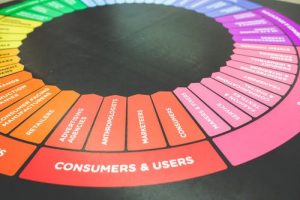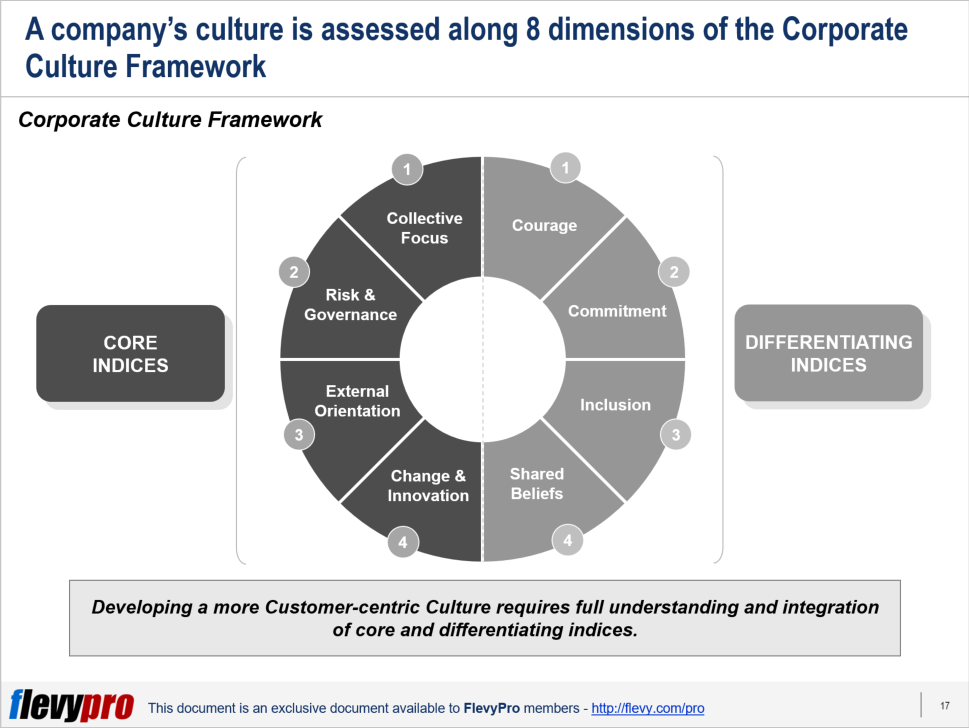Editor's Note: Take a look at our featured best practice, Customer-centric Organization: Core Capabilities (Part I) (24-slide PowerPoint presentation). Today's customers are better informed, better connected, and more demanding that ever before. CEOs are now concerned about Customer Loyalty and they recognize that mastery of the customer agenda is essential. In fact, global leaders of successful organizations recognize that creating a [read more]
How Do We Create a Customer-centric Culture?
Also, if you are interested in becoming an expert on Customer-Centric Design (CCD), take a look at Flevy's Customer-Centric Design (CCD) Frameworks offering here. This is a curated collection of best practice frameworks based on the thought leadership of leading consulting firms, academics, and recognized subject matter experts. By learning and applying these concepts, you can you stay ahead of the curve. Full details here.
* * * *
It’s the Age of the Customer. In this day and age, becoming a Customer-centric Organization is no longer just a differentiator–it is a necessity.
Customers are now more demanding. Their expectations are higher. In fact, they expect companies to anticipate their needs.
To truly become a Customer-centric Organization, we must adopt a Customer-centric Culture. Research has shown that a Customer-centric Culture can drive superior financial results.
So, what characterizes a Customer-centric Culture? Let’s begin by taking a look at the Corporate Culture Framework.
We see this Culture framework defines 4 core indices and 4 differentiating indices:
- Collective Focus – emphasis on collaboration, teaming, and cooperation in operations.
- Risk & Governance – focus on compliance, quality, and structure in operations.
- External Orientation – oriented towards customers and external environment.
- Change & Innovation – open to ambiguity, change, and risk to drive expansion and innovation.
- Courage – employees exhibit courage and resilience when confronting adversity, ethical dilemmas, failures, or opposition.
- Commitments – employees feel a sense of pride and ownership in the organization.
- Inclusion – accepts and promotes diversity, uniqueness, and authenticity.
- Shared beliefs – employees demonstrate commitment to organization-specific core values/beliefs.

- Collective Focus
- External Orientation
- Change & Innovation
- Shared Beliefs
Let’s dig a little deeper.
1. Collective Focus
Understandably, organizations that provide exceptional Customer Experience have strong collective focus. Collective focus means everyone in the organization is united in their understanding of their roles in delivering our Customer Value Proposition. Employees must internalize and appreciate this shared vision on what it means to deliver a great Customer Service.
To achieve this, significant resources must be devoted to communicating the Customer Value Proposition. Specifically, we must also conduct extensive employee training and coaching to ensure that company’s vision and value proposition are systematically represented in our service offerings and products.
Here are a several best practices related to enhancing our collective focus:
- Provide customer feedback in real time to all employees.
- Invest heavily in employee training and development to reinforce the company’s vision for serving customers.
- Listen to employee input to identify ways to improve the Customer Experience.
- Link employee and customer feedback systems so that employees can add important context.
2. External Orientation
Customer-centric companies that have strong external orientation are squarely focused on customers, competitors, and results. Employees must take an outside-in perspective, seeing themselves as customers see them.
3. Change and Innovation
Customer-centric companies place a premium on Change and Innovation.
By the way, we have Streams dedicated to each of these 2 areas:
We also have 2 Streams related to this central themes of this article:
Streams represent our most comprehensive offerings. Each Stream represents a bundle of best practice frameworks related to a specific management topic. We currently only have 14 Streams available.
An organization with a Customer-centric Culture has corporate belief system in place that values failing fast and learning quickly. The notion that mistakes are learning opportunities is embedded in the organization.
Customer needs and expectations are changing rapidly. Thus, we must innovate continuously to respond to these changes.
4. Shared Beliefs
In a Customer-centric Culture, employees find fulfillment in sharing the belief that servicing customers well is the priority.
Processes are created to reinforce customer-centric values and make them relevant to new employees.
Interested in gaining a better understanding of these cultural dimensions that drive customer-centricity? Take a look at our framework on Customer-centric Culture.
Do You Find Value in This Framework?
You can download in-depth presentations on this and hundreds of similar business frameworks from the FlevyPro Library. FlevyPro is trusted and utilized by 1000s of management consultants and corporate executives. Here’s what some have to say:
“My FlevyPro subscription provides me with the most popular frameworks and decks in demand in today’s market. They not only augment my existing consulting and coaching offerings and delivery, but also keep me abreast of the latest trends, inspire new products and service offerings for my practice, and educate me in a fraction of the time and money of other solutions. I strongly recommend FlevyPro to any consultant serious about success.”
– Bill Branson, Founder at Strategic Business Architects
“As a niche strategic consulting firm, Flevy and FlevyPro frameworks and documents are an on-going reference to help us structure our findings and recommendations to our clients as well as improve their clarity, strength, and visual power. For us, it is an invaluable resource to increase our impact and value.”
– David Coloma, Consulting Area Manager at Cynertia Consulting
“As a small business owner, the resource material available from FlevyPro has proven to be invaluable. The ability to search for material on demand based our project events and client requirements was great for me and proved very beneficial to my clients. Importantly, being able to easily edit and tailor the material for specific purposes helped us to make presentations, knowledge sharing, and toolkit development, which formed part of the overall program collateral. While FlevyPro contains resource material that any consultancy, project or delivery firm must have, it is an essential part of a small firm or independent consultant’s toolbox.”
– Michael Duff, Managing Director at Change Strategy (UK)
“FlevyPro has been a brilliant resource for me, as an independent growth consultant, to access a vast knowledge bank of presentations to support my work with clients. In terms of RoI, the value I received from the very first presentation I downloaded paid for my subscription many times over! The quality of the decks available allows me to punch way above my weight – it’s like having the resources of a Big 4 consultancy at your fingertips at a microscopic fraction of the overhead.”
– Roderick Cameron, Founding Partner at SGFE Ltd
“Several times a month, I browse FlevyPro for presentations relevant to the job challenge I have (I am a consultant). When the subject requires it, I explore further and buy from the Flevy Marketplace. On all occasions, I read them, analyze them. I take the most relevant and applicable ideas for my work; and, of course, all this translates to my and my clients’ benefits.”
– Omar Hernán Montes Parra, CEO at Quantum SFE

Want to Achieve Excellence in Customer-Centric Design (CCD)?
Gain the knowledge and develop the expertise to become an expert in Customer-Centric Design (CCD). Our frameworks are based on the thought leadership of leading consulting firms, academics, and recognized subject matter experts. Click here for full details.
In the modern Digital Age, advances in technology and communication, combined with the explosive growth in data information, have given rise to a more empowered global customer. Recent economic and political events highlight the need for organizations to understand how consumers view the world and the most important attributes for their purchasing decisions.
Thus, increasingly more organizations are seeking to invest and focus on Customer-centric Design. A clear understanding of customer needs and behaviors across the organization will help drive profitable growth strategies and provide the confidence to invest in opportunities at a time when staying within budget can be extremely difficult.
Learn about our Customer-Centric Design (CCD) Best Practice Frameworks here.
Readers of This Article Are Interested in These Resources

|
|
32-slide PowerPoint presentation
|
|
21-slide PowerPoint presentation
| |||
About David Tang
David Tang is an entrepreneur and management consultant. His current focus is Flevy, the marketplace for business best practices (e.g. frameworks & methodologies, presentation templates, financial models). Prior to Flevy, David worked as a management consultant for 8 years. His consulting experience spans corporate strategy, marketing, operations, change management, and IT; both domestic and international (EMEA + APAC). Industries served include Media & Entertainment, Telecommunications, Consumer Products/Retail, High-Tech, Life Sciences, and Business Services. You can connect with David here on LinkedIn.
Top 10 Recommended Documents on Customer-centric Organization
» View more resources Customer-centric Organization here.
» View the Top 100 Best Practices on Flevy.















